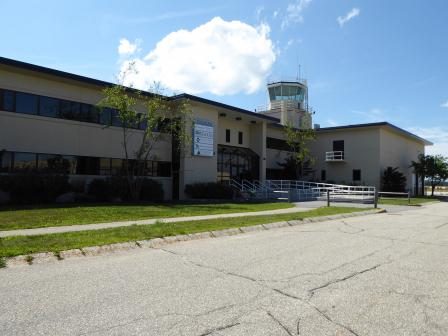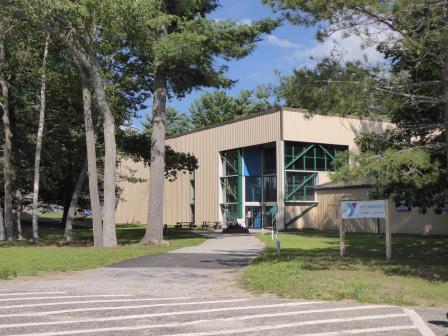Redevelopment Economics at Federal Facilities
 Brunswick Executive Airport at the Brunswick Naval Air Station siteSome innovative business owners and organizations reuse Superfund sites for a variety of purposes. These uses can help economically revitalize communities near Superfund sites. EPA has initiated efforts to collect economic data at a subset of federal facility Superfund sites.
Brunswick Executive Airport at the Brunswick Naval Air Station siteSome innovative business owners and organizations reuse Superfund sites for a variety of purposes. These uses can help economically revitalize communities near Superfund sites. EPA has initiated efforts to collect economic data at a subset of federal facility Superfund sites.
 YMCA at the Brunswick Naval Air Station siteThis research effort is an update and expansion of the research efforts conducted in 2016 and 2018 to provide current, reliable business-related information for a subset of federal facility Superfund sites in reuse and continued use. EPA's Federal Facilities Restoration and Reuse Office (FFRRO) updated information for the 16 sites researched in 2018 and added six new sites to the research effort. The effort identified a total of 1,422 businesses that generate $9.4 billion in annual sales and provide 115,097 jobs and nearly $7 billion in estimated annual employment income at 22 Federal Facility Superfund Sites.
YMCA at the Brunswick Naval Air Station siteThis research effort is an update and expansion of the research efforts conducted in 2016 and 2018 to provide current, reliable business-related information for a subset of federal facility Superfund sites in reuse and continued use. EPA's Federal Facilities Restoration and Reuse Office (FFRRO) updated information for the 16 sites researched in 2018 and added six new sites to the research effort. The effort identified a total of 1,422 businesses that generate $9.4 billion in annual sales and provide 115,097 jobs and nearly $7 billion in estimated annual employment income at 22 Federal Facility Superfund Sites.
Readily available internet and database sources are utilized to create estimates of national totals related to the beneficial effects of Superfund sites in reuse. Without more extensive research it is not always possible to identify all business names and addresses on site.
| Year | Sites in Reuse with Economic Data | Number of Businesses Identified | Reported Annual Sales (billions)* | Reported Jobs | Annual Employment Income (billions)* | Property Value (billions)* | Annual Property Tax (millions)* |
|---|---|---|---|---|---|---|---|
| 2016 | 11 | 628 | $5.8 | 40,000 | $3.1 | $2.1 | $9.9 |
| 2018 | 16 | 1,198 | $8.2 | 62,503 | $4.4 | $4.3 | $24 |
| 2019 | 22 | 1,422 | $9.4 | 115,097 | $7 | -- | -- |
| Note: These are estimates of economic activity at federal facilities Superfund sites based on methodology developed by EPA’s Superfund Redevelopment Initiative. Data on businesses, jobs and annual sales were obtained from Hoovers/Dun & BradstreetExit, ReferenceUSAExit, Manta.comExit and other published reports identified online. These databases and reports include data reported by businesses. Accordingly, some reported values might be underestimates or overestimates. In general, economic information gathered for sites in reuse is conservative, as it is not always possible to identify all businesses on site. In some cases, the economic information presented may not be comprehensive of the entire site. Wage data are from the Bureau of Labor Statistics (BLS) Quarterly Census of Employment and Wages and are used to estimate annual income based on the number of jobs identified at the business and the average weekly wage reported by BLS for each business’s primary NAICS code and location. Property values and property taxes were identified using local government data sources. When assessed values were available but property taxes were not, property taxes were estimated based on the identified assessed value and local tax rates. Again, the property values of all property at the site may not be included because either the property was not identified, a property value was not available or the property was owned by local, state or federal government agencies, and therefore, had an assessed value of zero. Note that * indicates that the values were adjusted to 2018 USD using the Consumer Price Index (CUUR0000SA0, not seasonally adjusted, U.S. city annual average). | |||||||
Information about FFRRO Site-Specific Economic Highlights
The reuse of Superfund sites provides a wide range of benefits to local communities across the country. Some of these benefits are easy to quantify, while others are not. For example, commercial or industrial reuse of a site can bolster local economies by supporting jobs and generating sales revenues. However, not all sites in reuse involve an on-site business or other land use that would employ people. Therefore, economic information is not available for all sites in reuse. This could be attributed to several factors, including:
- There may be no revenue-generating businesses operating on site.
- There may be a business or businesses operating on site for which economic information is not available.
- FFRRO has only explored the businesses operating at Federal Facility Superfund Sites for a subset of sites in reuse.
Many sites without businesses have beneficial effects that are not easily quantified, such as properties providing ecological or recreational benefits (e.g., parks, wetlands, ecological habitat, open space). Also, not all sites in reuse are well-suited for revenue-generating reuse. If a site is not located in an area appropriate for commercial or industrial reuse, it may not be a realistic option to have it redeveloped into something that will support jobs. EPA’s Superfund Redevelopment Initiative quantifies many types of beneficial effects of reuse at Superfund sites including the number of on-site jobs, estimated annual employment income and sales revenue generated by on-site businesses.
EPA obtains economic data for sites in reuse from reputable sources. Information on the number of employees and sales volume for on-site businesses typically comes from the Hoovers/Dun & Bradstreet (D&BExit) database. When Hoovers/D&B database research is not able to identify employment and sales information for on-site businesses, EPA uses the ReferenceUSAExit and MantaExit databases. These databases include data reported by businesses. Accordingly, some reported values might be underestimates or overestimates. In some instances, business and employment information come from local newspaper stories/articles and discussions with local officials and business representatives. In general, economic information gathered for sites in reuse is conservative, based on available resources. In some cases, especially for exceptionally large sites, the economic information presented may not be comprehensive of the entire site, presenting a conservative estimate of the economic benefits of reuse at the given site.
